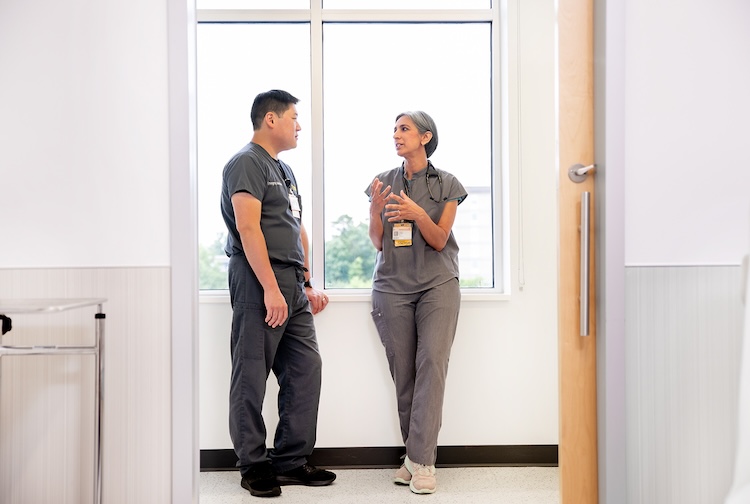COVID-19 and home learning: Tips for creating a healthy learning space for kids
CHoR occupational therapist Jessica Lynn explains how you can create a comfortable work space for students learning virtually.
September 15, 2020 Home Learning
Home Learning
For students who are returning to school virtually this year, their “classroom” might look a little different than normal. Occupational therapist Jessica Lynn offers tips for parents and guardians to help kids feel focused, comfortable and ready to learn.
How to set up your child's work station
Proper seating helps ensure that your children are comfortable, focused and prepared to learn. It also sets them up for success while spending long periods of time looking at a screen.
You don't need to go out and buy a new child-sized desk to have a successful work station. It's perfectly fine to use an existing desk or the kitchen table. Here are a few easy ways to modify your set-up:
- Have your children's hips, knees and elbows positioned at right angles. Their elbows should rest on the table or desk but not so low that they have to bend over to write.
- Use a pillow behind their back to decrease the depth of their seat and have their knees rest at 90 degrees. If they aren't high enough, place books or a box on the seat to boost them up. You can even try using their booster seat from the car.
- Your student's feet should be flat on the floor. If the chair is too high, place a step stool or sturdy box under their feet.
- It is also important to have the top of their screen at eye level to keep their neck in a neutral position (not bending forward to look down or backward to look up). Place the laptop or tablet on top of a box or stack of books so it is at the right height.
- The screen should be about 18-24” away from your child's face. Consider a wireless keyboard and mouse if your children can't reach the laptop when it is at the appropriate height.
Dedicate space for school
It is important to set aside a dedicated space in your home for school. If the space you choose must serve another function at another time of day, such as a dining room table, think about how you can make it mobile for easy clean up. For example, put all supplies and materials in a basket that can be put aside when the school day is over so that the kitchen table is clear for dinner. If the kitchen table is unavailable, think outside of the box. Do you have a closet that you could trade out winter jackets for a small desk?
Consider creating multiple “work zones,” as novelty often helps improve focused attention. This may look like sitting at a desk for focused work, completing large projects at the dining room table to allow your student to sprawl out, and reading in a cozy nook. Try to set up workspaces where you have access to good lighting. Dark rooms can cause eye strain. Consider window and lamp placement. Avoid bright lights behind the computer, as they can produce glare. Don't forget to make sure there is a power source nearby to charge their device.
Finally, allow your children to be a part of setting up and personalizing their new space. Hang a small bulletin board for their daily schedule and to showcase their work. Limit distractions while they are learning
If you have multiple virtual learners working alongside each other, consider investing in headphones with a microphone. Another way to limit environmental sounds is to use white noise. There are even free sound machine apps that can be downloaded to an extra phone or tablet.
If your children are working in an area of the house with traffic, position their workspace so that it is facing the wall instead of out towards the room. If this is not possible, buy a trifold presentation board to create a cubicle. Let your students decorate the trifold to reflect their interests.
Organize materials
New school supplies can be motivating for some children, but purchasing all new supplies isn't necessary. Use a cup or jar to store writing utensils and keep all other supplies in an easy-to-reach box or container. You can even use something like an aluminum baking pan to store markers and crayons. Let your children personalize their supply boxes before school starts or as a fun activity during a break the first week of school. Most schools have provided supply lists, and some even provide virtual learning kits. Don't forget supplies that may not be included on traditional school supply lists, like a pencil sharpener, stapler and 3-ring hole punch. Keep plenty of lined and unlined paper available.
Get the wiggles out - alternative seating options for kids who have trouble focusing
For children who might have trouble focusing, try these alternative seating options that have movement built into them. This movement will cause children to move with the chair while making sure they stay upright, reducing the need for them to seek out movement in a way that interferes with learning. Flexible seating options include:
- Yoga ball (if small enough, you can place inside a plastic crate so that it doesn't roll away)
- Chair ball with feet
- Scoop chair
- Inflatable cushion/balance disc
- Wobble stools
- Stack of couch cushions
Tips to help children with ADHD or special needs that impact their ability to focus:
- Use a timer to help your child remember when they need to return to the computer after a break
- Post a daily schedule that is always visible. Students may need frequent reminders to reference it.
- Consider color-coding to indicate times when live teacher-led classes are occurring versus when individual work is taking place.
- Make sure break times include physical activity.
- Staying organized is often an area of difficulty for kids with ADHD, so it's important to help them with this.
- Alternate more difficult parts of the school day with those that are more preferred.
- If possible, present learning in smaller chunks of time to reduce the demand for sitting still for long periods of time.
Our experts at CHoR are dedicated to helping students return to school safely, whether that is in-person or online. For more tips and advice on keeping kids safe during COVID-19, please visit the CHoR COVID-19 resource section.




